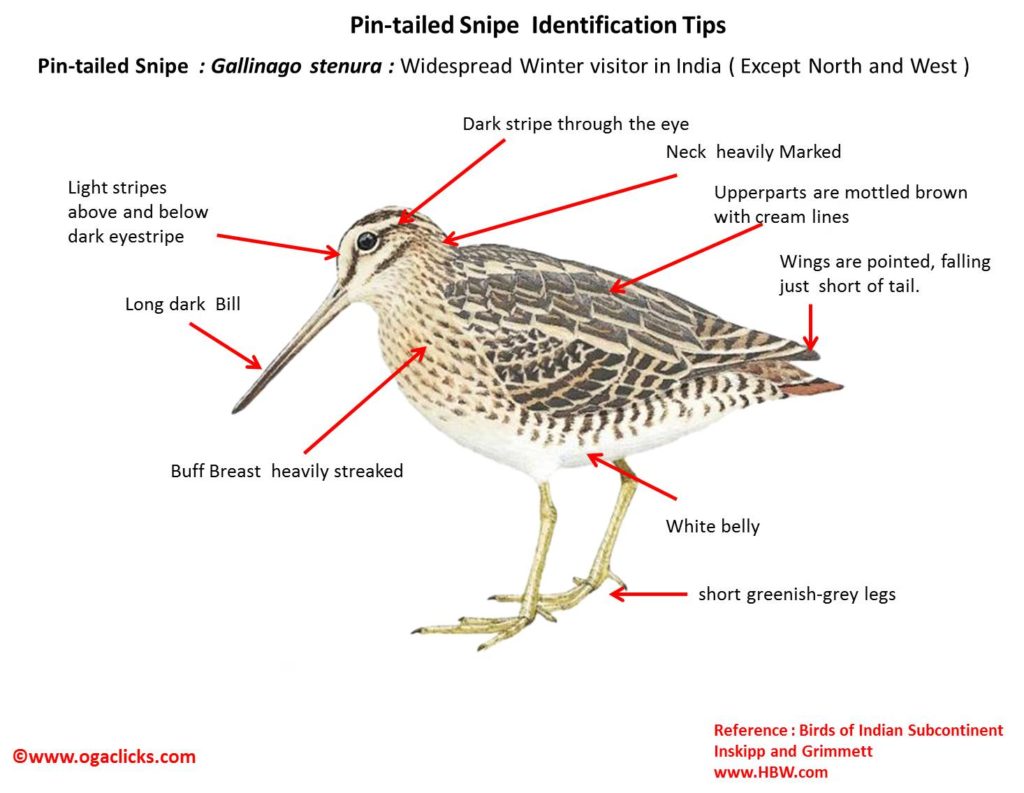Pin-tailed Snipe

Pin-tailed Snipe Gallinago stenura
Etymology:
- Gallinago : Latin word for Woodcock or Snipe
- Stenura : Greek word tenos-narrow, thin; ouros-tailed.
Vernacular Names: Sind: Likpakhi, Hindi: Sink Dum Chaha, Ben: Kadakhocha, Chegga, Ass: Khochasorai, Chahasorai, Chergya,Cachar: Dao didap, Nepal: Bharak, Mani: Cheklaobi, Kuki: Vohtialin, Naga: Ti inrui, Guj: Garkhod, Salipunchhgarkhod, Mar: ShankuPanlawa, Ta: Morullan, Korrakothi, Te: Mukupuredi, Mal: Chuntan kata, Sinh: Keswatuwa
Distribution in India: Widespread winter visitor except in North and West of India in India.
Description: Size of 25–27 cm; Wt. of 84–182 g; wingspan of 44–47 cm. It is a medium-sized snipe, with primaries only just longer than tertials, and tail projects only slightly beyond primaries. The wing-coverts have brown-buff spots at tip; has short tail, with distinctive pin-shaped outer tail feathers, not usually visible in the field; in flight, toes project beyond tail tip. The wings are rounded. It has densely barred underwing-coverts and pale upperwing coverts. It has a bulging supercilium with little contrast between the buff supercilium and cheeks. The eye stripe is narrow in front of eye and poorly defined behind it. Width and colour of edges to lower large scapulars is similar on inner & outer webs creating a scalloped appearance .The female very similar to male, but bill averages slightly longer. No seasonal variation. The juvenile is very similar to adult, but with pale buff fringes on wing-coverts and narrower fringes on upperparts.
Habitat: It is found in breeding season in Arctic and boreal wetlands, damp meadows and shrub tundra with patches of dwarf birch up to 2500 m, along tree-line. After breeding, it is found in wide variety of wetland habitats, flooded paddy fields, wet grassland, seepage swamps and marshland.
Food habits: It eats molluscs, insects and their larvae, earthworms, occasionally crustaceans, seeds and other plant matter. It feeds by probing in soft ground, or pecking from surface. It is Crepuscular, nocturnal and, when undisturbed, diurnal. It often feeds on muddy shorelines and stream banks.
Breeding habits: They breed inMay to Jun. They are monogamous. They have a dazzling communal aerial display called “Tok”, in which flock of up to 15 males suddenly plunges sideways, or each male glides and falls downwards, turning from side to side, whilst uttering frequent cries and producing sounds with modified tail feathers. The nest is a shallow depression lined with vegetation, usually well concealed by dense cover. They lay a clutch of 3-4 eggs, laid at intervals of 24 hours. The incubation period is 20 days. The chicks are independent after 2 months.